エネルギー貯蔵への応用のための酸化鉄ベースのナノ構造の進歩
要約
地球環境やエネルギー問題をきっかけに、日常生活におけるグリーンで効率的なエネルギー貯蔵装置の需要は絶えず高まっています。重要なエネルギー貯蔵装置であるリチウムイオン電池(LIB)が注目されています。 LIBアノードにはグラファイトを使用していますが、理論容量が小さいため、より容量の大きいLIBアノードを開発する必要があります。近年のLIBアノードとしての新規酸化鉄とその複合材料の応用戦略と研究の進歩をこのレビューにまとめています。ここでは、気相堆積、共沈、電気化学的方法など、さまざまな酸化鉄ベースのナノ構造を得るためのいくつかの典型的な合成方法を列挙します。酸化鉄ベースのナノ構造の特性評価、特にその場でのX線回折および 57 Feメスバウアー分光法が詳しく説明されています。さらに、酸化鉄ベースのナノ構造とその複合材料の電気化学的用途について説明し、要約します。
グラフィックの要約
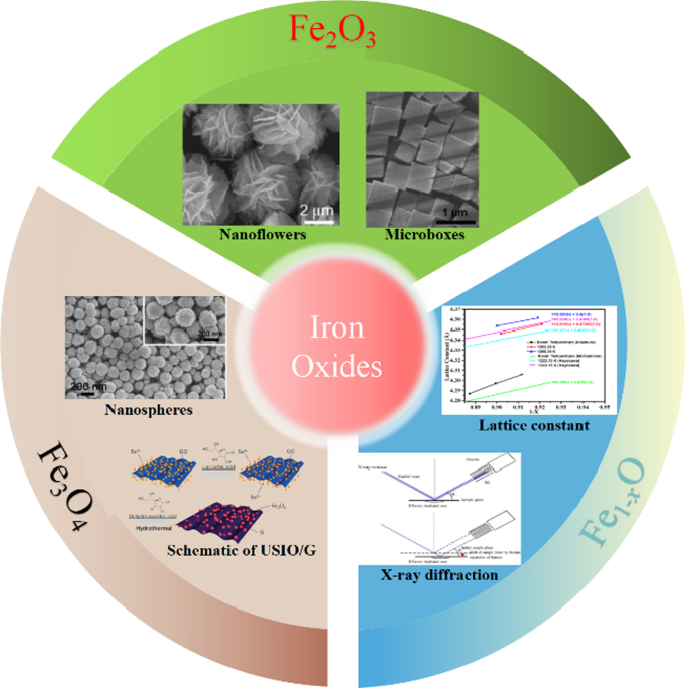
はじめに
世界的なエネルギーと環境の問題により、太陽エネルギー、燃料電池、リチウムイオン電池(LIB)、熱電モジュールなどの高効率のグリーンエネルギーに対する需要が高まっています。[1,2,3,4,5,6、 7,8,9,10,11]。高性能で低コストのエネルギー貯蔵システムの研究開発は、これらの問題の重要な解決策です。幅広い用途のエネルギー貯蔵装置の中で、LIBは非常に効果的なエネルギー貯蔵システムの重要な候補です[12、13、14、15、16、17、18、19、20、21、22、23、24]。ただし、現在の市販のグラファイトアノードには制限があります。たとえば、理論容量が比較的低い(372 mA h g -1 )。 )、およびいくつかの電気化学的に活性な材料がLIBに適用されることが提案されている[25、26、27、28、29]。 2000年に、Poizot等。 [30]は、遷移金属酸化物(TMO)は、グラファイトの2〜3倍の高い理論容量があるため、LIBの一種の重要なアノードと見なされていると報告しています。したがって、TMOおよび関連する複合材料はLIBアノードとして大きな注目を集めています。リチウムの挿入/抽出プロセス中に、TMOは次の反応を示します[31]。
$$ {\ text {M}} _ {x} {\ text {O}} _ {y} + 2y {\ text {e}} ^ {-} + 2y {\ text {Li}} ^ {+} \ leftrightarrow x {\ text {M}} ^ {0} + y {\ text {Li}} _ {2} {\ text {O}} $$(1)ここで、MはNi、Cu、Fe、Coなどを表します。リチウム挿入プロセス中に、これらの酸化物はリチウムによって還元され、金属クラスターからなる複合材料がアモルファスLi 2 のマトリックスに分散します。 Oが形成されます[30、31]。
TMOの中で、酸化鉄ベースのアノードは、豊富さ、低コスト、無毒性などの利点を備えているため、LIBで大きな可能性を秘めた優れた候補の1つです[32、33]。ただし、他のTMOと同様に、LIBアノードとして機能する酸化鉄には2つの重大な問題があります。 1つは、最初の放電プロセスでの電解質の分解と固体電解質界面(SEI)層の形成によって引き起こされる、大きな不可逆容量です。さらに、FeとLi 2 の形成 Oは熱力学的に実行可能であり、リチウムイオン(Li + )Li 2 から Li + の一部であるため、Oは熱力学的に不安定です[34] Li 2 から抽出できません Oは1回目の放電プロセスで形成されます。これはまた、部分的に不可逆的な容量をもたらします。もう1つの問題は、主にLi + の挿入/脱挿入におけるFeの大きな体積変化と深刻な凝集に起因する、サイクリングの安定性の低さです。 、電極の粉砕と容量の急速な低下につながります[3]。これらの問題を解決するために、これらの問題を克服することに多くの努力が注がれており、いくつかの非常に効果的なアプローチが提案されています。私たちの知る限り、非常に効果的な戦略の1つは、酸化鉄のナノ構造化です[3、35]。いくつかのユニークなナノ構造では、ひずみと体積の変動は、Li + の挿入/取り外しに起因していました。 Li + も大幅に抑制されます 電極内で容易に拡散できるため、アノードの電気化学的性能が大幅に向上します[11]。さらに、酸化鉄と合成するために、炭素繊維(CF)、カーボンナノチューブ(CNT)、グラフェン、熱分解炭素などの炭素質材料が導入されています[36、37、38]。充電/放電中の複合電極の体積変化は、独自の構造を持つこれらの炭素質材料によって緩衝できるため、酸化鉄ナノ構造の電子接触とサイクル安定性が向上します。
このレビューでは、酸化鉄(Fe 1- x )に関する最近開発された戦略と重要な研究の最新情報を紹介します。 O、Fe 2 O 3 、Fe 3 O 4 )LIBおよびスーパーキャパシターに適用されるベースのナノ構造が詳細に説明され、要約されています。具体的には、酸化鉄ベースのナノ構造の合成と設計、およびそれらの電気化学的性能に焦点を当てました。
ウスタイト(Fe 1- x O)
ウスタイト(Fe 1- x O)は0 < x の非化学量論的化合物です <0.0464 [11]。岩塩立方構造であり、格子定数は〜4.330Åです[11]。 Fe 1- x O、Fe 2 と比較 O 3 およびFe 3 O 4 は、比容量が比較的低く、843.15 K未満の準安定相であるため、エネルギー貯蔵への応用が少なく、FeとFe 3 に分解する傾向があります。 O 4 。ただし、Fe 1- x LIB用の非常に有望なアノードであるOは、Fe 2 よりも高い電気伝導率を持っています。 O 3 およびFe 3 O 4 。
合成と特性評価
私たちが知る限り、高性能カバレッジを備えたTMOの合成は、高性能LIBアノードの大きな可能性を秘めています[7]。 LIBでは、ウスタイトアノードの電気化学的メカニズムは次の式で表されます[8]。
$$ {\ text {FeO}} + 2 {\ text {Li}} ^ {+} + 2 {\ text {e}} ^ {-} \ leftrightarrow {\ text {Fe}} + {\ text {Li }} _ {2} {\ text {O}} $$(2)FeO / C複合材料は、Gao etal。による簡単な方法を使用して合成されました。 [31]。それらの合成では、α-Fe 2 O 3 サイズが30〜120 nmの粒子を、さまざまな割合のアセチレンブラック(AB)と混合し、ボールミル粉砕によって均一な混合物が得られました。次に、α-Fe 2 の混合物 O 3 そしてABはN 2 で800°Cで10時間炭素熱還元されました 均一なFeO / C複合材料を得るための雰囲気。 FeO / C複合材料は、Fe 2 よりもはるかに高いサイクル安定性を備えています。 O 3 / AB混合物。 ABの含有量が50wt。%の場合、FeO / C複合材料の容量は511mA h g -1 、396 mA h g -1 より高い のFe 2 O 3 / AB。さらに、50サイクル後の容量保持率は> 96%であり、Fe 2 よりも明らかに70〜80%高くなっています。 O 3 / AB。 FeO / C複合材料の優れた電気化学的性能は、炭素熱還元後のFeO粒子とAB粒子の結合の強化に起因する、より高い電気伝導率に起因すると考えられます。
その後、2016年にJung etal。 [11] KをFe 2 に熱拡散させることにより、KドープFeOナノ粒子に基づくLIBアノードとしてカリウム(K)-FeO /グラフェン複合材料を調製しました。 O 3 /ポリオール還元を使用したグラフェン。菱面体晶Fe 2 O 3 結晶はFeO結晶(面心立方、FCC)に変換され、KドープFe 2 の焼成により、(111)結晶面の広いd間隔(5.2Å)を示しました。 O 3 /グラフェン。以前に研究されたFe 2 との比較 O 3 /グラフェン複合材料[11]、K-FeO /グラフェンは1776mA h g -1 の放電容量を示しました 100 mA g -1 の電流密度で50サイクルの間に高いサイクル安定性を備えています 、一方、Fe 2 O 3 /グラフェンは1569mA h g -1 の放電容量を実現しました 。 18.56 A g -1 の高電流密度でも 、K-FeO /グラフェンの容量は851mA h g -1 のままでした 800サイクル後。この差は、18.56 A g -1 の高電流密度で電極をより長くサイクルさせた後、はるかに大きくなります。 。図1に示すように、Fe 2 と比較して O 3 /グラフェン、K-FeO /グラフェンアノードは独特の結晶構造と反応機構を持っています。 K-FeO /グラフェンの高い放電容量は、追加のLi + のストレージによる特定の容量を示しています Fe 2 へのカリウム拡散を介して、ウスタイト格子内の空孔と広いd間隔から寄与されるはずです。 O 3 格子。
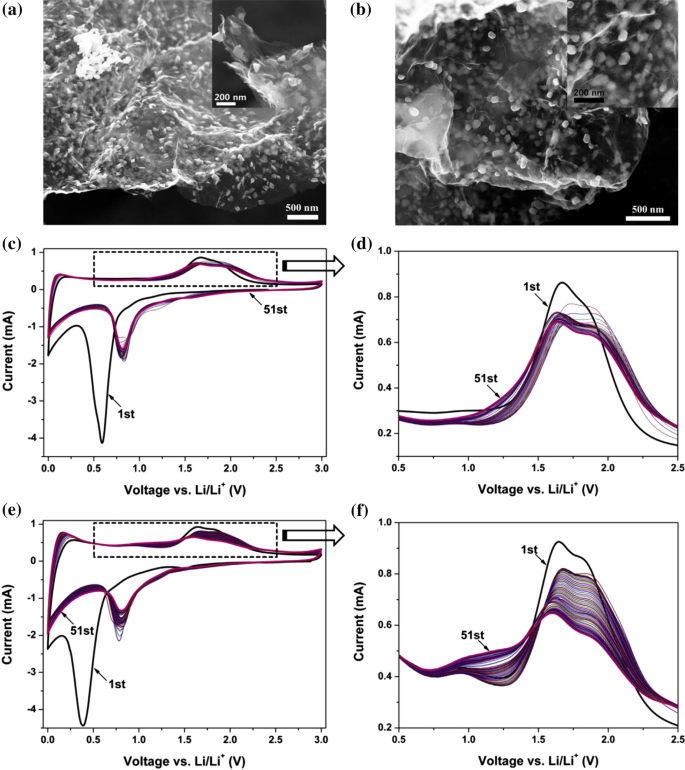
[11]の許可を得て転載。 Copyright、Elsevier B.V
a のSEM画像 Fe 2 O 3 /グラフェンと b K-FeO /グラフェン、および( a の挿入図 、 b )はそれぞれ拡大画像です。 c の繰り返しサイクリックボルタモグラム 、 d Fe 2 O 3 /グラフェン電極と e 、 f K-FeO /グラフェン電極。 0.5 mV s -1 の電位掃引速度で、2つの電極を51サイクルの間継続的にスキャンしました。 。
その場X線回折
その場X線回折(XRD)により、サンプルの反応過程におけるリアルタイムの構造変化の情報と、大量の比較可能な情報を短時間で取得できます。合成プロセス中のサンプルの構造変化を観察できるだけでなく、特定の電位への充電/放電下でのさまざまな温度でのサンプルの対応する構造変化を検出するためにも使用できます。これは、実際の反応メカニズムを監視するのに非常に役立ちます。電池の陽極/陰極の。さらに、私たちのグループは、高温での物理的および化学的特性の調査に必要なウスタイトの格子定数の正確な知識を研究しました。 Fe 1- x Oは、特定の回折ピークを測定するための平行ビーム(図2a)を備えた高温X線回折計(RINT2000-TTR、理学伝記株式会社)によって合成され、特性評価されました。高温でのウスタイトも調査されます。 α-Fe(95 wt。%)およびFe 3 を使用したウスタイトの合成プロセス O 4 (99 wt%)初期材料としての粉末は共析反応です(図2b)。この反応は、特定のPco / Pco 2 で843.15〜1673.15Kの間で進行します。 ウスタイトは843.15K未満では不安定であり、反応物は19%Fe(wt。%)および81%Fe 3 であるため、 O 4 (重量%)。図2cは、初期反応物(マグネタイトと鉄)のXRDパターンを示しています。実験条件を表1に示します。ヘリウム(He)ガスをパージした後(25 ml min -1 )XRDシステムの炉に60分間入れ、反応物を10°Cmin -1 の一定速度で加熱しました。 サンプルの温度が843.15Kに達するまで、これもHe雰囲気で、流量は25 ml min -1 。その後、Heガスが排出され、CO / CO 2 特定の比率(たとえば、1:1と1:2)のガスを炉にパージしました。 Auフレークを溶かして高温を校正した後、サンプルホルダーの実際の温度を得ることができました。 843.15 Kから目的の温度(1265.28および1365.28 K)まで、加熱速度は2°Cmin -1 でした。 XRDを使用して、ウスタイト相を確認するためのサンプルを測定しました。サンプルを目的の温度で保存し、そのほとんどがウスタイト相である場合、ウスタイトの結晶面の回折角を240〜420分間測定し、サンプルの温度を50°C上昇させてこの温度を維持しました。 60分間。これらの手順の後、サンプルの温度は以前の望ましい温度に低下し、ウスタイトの結晶面の回折角のXRD測定が180〜240分の期間で再度実行されました。
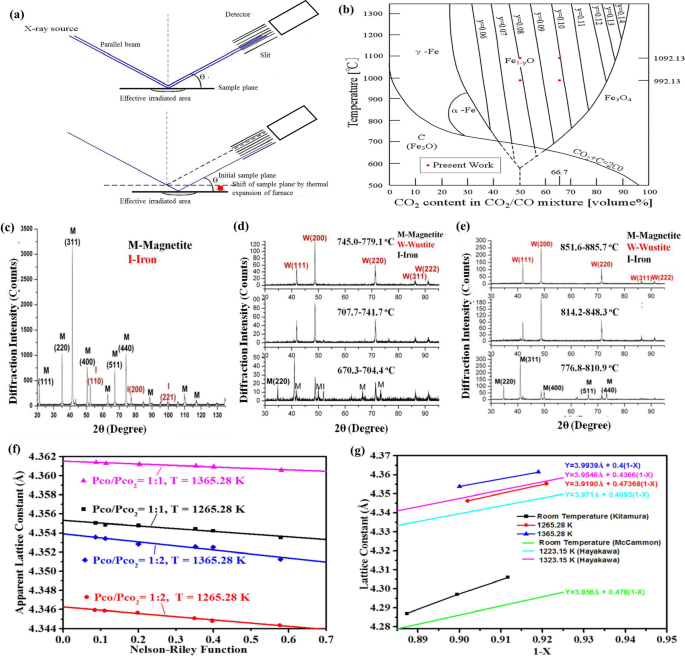
a in-situXRDの概略図。 b Fe、Fe 1- y 間の平衡 O、Fe 3 O 4 、CO、CO 2 、およびカーボン。 c 初期反応物のXRDパターン。 d Pco / Pco 2 で合成されたサンプルのXRDパターン =1:1。 e Pco / Pco 2 で合成されたサンプルのXRDパターン =1:2。 f 異なるNR関数-異なる温度およびPco / Pco 2 で合成されたウスタイトの見かけの格子定数 。 g ウスタイトの格子定数の結果
格子定数は、見かけの格子定数をこの関数のゼロに線形外挿することで取得できます。つまり、2シータ=180°です。ウスタイトの(111)、(200)、(220)、(311)、および(222)結晶面の回折ピークを図2d、eに示し、サンプルのXRDパターンをPco / Pcoで取得します。 2 それぞれ1:1と1:2の。異なるPco / Pco 2 の下での見かけの格子定数とNelson–Riley関数の関係 図2fに示すように、温度が得られます。直線は、データに適合する正方形を表します。これらの直線を使用して、見かけの格子定数をNelson–Riley関数のゼロに外挿しました。したがって、図2fに示すように、さまざまな温度とPco / Pco 2 で得られた真の格子定数の結果 は4.355Å(1265.28 K、Pco / Pco 2 =1:1)、4.346Å(1265.28 K、Pco / Pco 2 =1:2)、4.362Å(1365.28 K、Pco / Pco 2 =1:1)および4.354Å(1365.28 K、Pco / Pco 2 =1:2)、それぞれ。図2gに示すように、格子定数は x の増加とともに増加します。 Fe 1- x の O、そして温度が高いほど、格子定数は大きくなります。高温でのウスタイトの組成と格子定数の関係は、次の式で求めることができます。 (3)と(4)。
$$ {\ text {a}} \、\ left({{\ AA}} \ right)=3.919 + 0.474 \ left({1-x} \ right){} \ left({1265.28 \、{\ text {K}}} \ right)$$(3)$$ {\ text {a}} \、\ left({{\ AA}} \ right)=3.994 + 0.400 \ left({1-x} \ right ){} \ left({1365.28 \、{\ text {K}}} \ right)$$(4)57 Feメスバウアー分光法
57 Feメスバウアー分光法には、原子核のエネルギー準位構造や原子核が存在する化学的環境など、原子核の特性が含まれます。したがって、それに応じて、原子の原子価、化学結合のイオン性、配位数、結晶構造、電子密度、およびサンプルの磁気特性を研究するために適用できます。 57 Feメスバウアー分光法は化学や材料の分野で広く利用されています。ここでは、 57 について詳しく説明します。 酸化鉄を特徴づけるためのFeメスバウアー分光法。 57 Feメスバウアー分光法は、さまざまな酸化鉄相を区別および特性評価し、結晶格子内のFe原子の局所環境を監視するために使用されます[39、40]。
異性体シフト(IS)、四重極分割(QS)、四重極シフト(ɛ)などの超微細パラメーター Q )および超微細磁場( B hf )は、メスバウアースペクトルのスペクトル線の位置を分析することで取得できます[41、42]。サンプルの特性は、スペクトル線の幅と非対称性から推測できます。超微細パラメータの温度および電界依存性により、貴重なパラメータを推定することもできます。
Aldon etal。 [42] Fe 1- x のリチウム誘起変換反応を研究しました O 57 を使用 Feメスバウアー分光法。超微細パラメータ(ISおよびQS)は、反強磁性(TN =198 K [43])Fe 1- x のFeII種にかなり特徴的です。 O、室温(RT)での典型的な常磁性吸収を示しています。 57 に示されているように Feメスバウアースペクトル(図3a)には、IS〜1 mm s -1 の3つの広がったダブレットがあります。 QSの範囲は〜0.50〜1.50 mm s -1 、およびそれらの相対面積は、α-Feの磁気的寄与から補正されます。吸収強度は42、26、15%です。 IS〜0.55 mm s -1 を中心とする4番目のダブレット 、QS〜0.90 mm s -1 相対面積が11%の場合、FeII I では一般的です。 非化学量論的Fe 1- x で予想される種 O. FeII / FeII I から 比率では、空孔の量は〜0.057±0.008と推定され、XRD特性評価により0.050に近づきます。最後に、QS〜1.68 mm s -1 にあるダブレット およびIS〜0 mm s -1 、α-Feに対応し、〜6%の寄与をします。
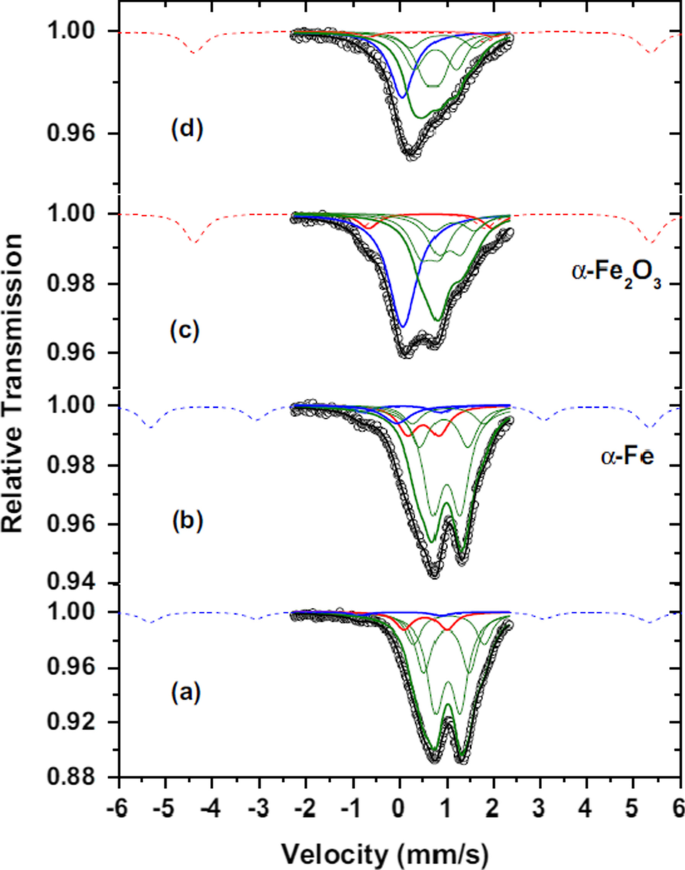
[42]の許可を得て転載。 Copyright、Elsevier Masson SAS
57 の比較 自然のままのFe 1- x の300KでのFeメスバウアースペクトル O素材( a )、1 Liの摂取後( b )および2.16 Li( c )。グリーン貢献はFeIIに起因します。太い緑色の線は、未反応のFe 1- x に対応する細い線の合計です。 O.青い破線は、( a からのα-Feの予想される増加する寄与に対応します。 )から( c )。 ( c の場合 )、磁気セクステットは目のガイドとしてわずかにシフトされています。スペクトル( d )は、0.94 Liでの最初の電荷の終わりに対応し、α-Feの寄与はありませんが、青色の一重項ナノサイズの金属ε-Fe 0 まだ存在しています。
Fe 2 との比較 O 3 およびFe 3 O 4 、Fe 1- x の比容量 Oが最低です。その上、その合成方法はより複雑です。ほとんどの場合、高温での還元反応は避けられません[3,4,5,6、9、11]。その結果、Fe 1- x OはFe 2 と比較して理想的なLIBアノードではありません O 3 またはFe 3 O 4 。
Fe 2 O 3 ベースのナノ構造
これらの酸化鉄の中で、特にFe 2 O 3 は、1000 mA h g -1 に達する可能性がある高い理論容量により、多くの研究者の注目を集めています。 [44]。さらに、Fe 2 O 3 耐食性が高く、製造コストが低く、環境に優しく、不燃性、非毒性、高い自然利用性など、独特の利点があります[45]。これらの優れた特性により、Fe 2 O 3 LIBアノードでのアプリケーションに非常に有望です[46、47、48、49、50]。ここでは、Fe 2 の合成、特性評価、および電気化学的性能に関する最近の開発の簡潔な概要を説明します。 O 3 ベースのナノ構造が提供されます。
合成と特性評価
過去10年間で、Fe 2 の合成方法を探求するための多大な努力がありました。 O 3 ベースのナノ構造。このセクションでは、Fe 2 の合成方法を詳しく説明して要約しました。 O 3 気相堆積[51]、溶液ベースの方法[52]、電気化学的方法[53]、熱処理[54]および他の方法[55、56]を含むベースのナノ構造。また、さまざまな合成方法を比較しました。
さらに、 57 Fe 2 のFeメスバウアー分光法による特性評価 O 3 ナノ構造について詳しく説明します。特定の原子核だけが共鳴吸収を持っているので、 57 Feメスバウアー分光法は他の元素に干渉されません。 57 の範囲 細胞質外環境の影響を受けるFeメスバウアー分光法は、一般に数ナノメートル以内であるため、ナノ構造の特性評価に非常に適しています。
気相堆積
気相堆積は、Fe 2 などの多くの薄膜やその他のナノ構造の合成に広く適用されています。 O 3 および他の酸化鉄ベースのナノ構造。化学蒸着(CVD)、原子層堆積(ALD)、物理蒸着(PVD)、電解蒸着、反応性スパッタリングは、気相蒸着の典型的な方法です[57,58,59,60]。
ALDは、高結晶化度の薄膜を合成するための独自の方法であり、液相堆積よりも安価な方法です。 ALDプロセスでは、すべての層の化学反応が前の層に直接付随します。このようにして、反応サイクルごとに1つの層のみが堆積されます。たとえば、Lin etal。 [51] ALDを利用して、高品質の極薄α-Fe 2 を堆積しました。 O 3 TiSi 2 のフィルム ナノネット。 3D自己組織化ナノポーラス薄膜はYangらによって製造されました。 [61] CVDを介して、不均一なFe 2 に統合されます O 3 / Fe 3 C-グラフェン。 LIBアノードとして、この薄膜を堆積することにより、レート容量とサイクル性能を大幅に向上させることができます。 Cesar etal。 [62]シリコンをドープしたFe 2 の薄膜を堆積 O 3 Fe 2 を生成する大気圧CVD(APCVD)による樹枝状ナノ構造 O 3 前例のない効率で可視光の下で水を酸化する光陽極。樹枝状α-Fe 2 O 3 ナノ構造は、0.5cm 2 の巨視的表面積を示した [62]。垂直に整列したα-Fe 2 O 3 ナノロッドアレイは、Wuらによる有機金属CVD(MOCVD)を介してシリコン基板上に成長します。 [63]。さらに、Jia etal。 [64]は、高周波スパッタリング堆積を利用して、α-Fe 2 を製造しました。 O 3 極薄フィルム。
気相堆積は高品質のFe 2 を調製することができますが O 3 ベースのナノ構造には、欠点もあります。たとえば、APCVDとMOCVDは、前駆体のプロセスにおいて高い毒性と可燃性を持っています。
ソリューションベースの合成方法
溶液ベースの合成法は一般的であり、Fe 2 を製造するのに簡単です。 O 3 およびその他の酸化鉄。 Fe 2 O 3 ナノフラワー[65]、ナノスフェア[66]、ナノ粒子[67]、ナノロッド[68]、ナノチューブ[14]、ナノリング[69]、ナノベルト[70]、ナノフレーク[71]、ナノワイヤー[72]などのさまざまな形態を持ちます。 、ナノファイバー[73]、およびマイクロボックス[54]は、溶液ベースの方法、たとえば、熱水、ソルボサーマル、およびゾルゲルアプローチによって合成されました。これらの方法は非常に簡単で利用可能です。 Zhong etal。 [65]はソルボサーマル法を使用してFe 2 を製造しました O 3 エチレングリコールを介した自己組織化プロセスによるナノフラワー(図4)。 Vayssieres etal。 [52]は多孔質Fe 2 の成長を報告しました O 3 水熱プロセスによるフッ素ドープ酸化スズ(FTO)導電性ガラス上のナノロッドアレイ。 α-Fe 2 の水熱成長による O 3 SnO 2 の前駆体 ナノワイヤーステム、新しい6回対称分岐α-Fe 2 O 3 / SnO 2 ヘテロ構造(図5)が合成されました[74]。 Fe 2 を合成するための、もう1つの簡単で経済的な手法であるゾルゲル法があります。 O 3 ナノ構造。 Woo etal。 [68]は、ゾルゲル法を利用してα-Fe 2 を取得しました。 O 3 遍在するFe 3+ の反応によるナノロッド 逆ミセルで。このメカニズムによって得られたナノロッドは、低次元性と高表面積を持っており、マグネタイトとウスタイトに拡張することができます。
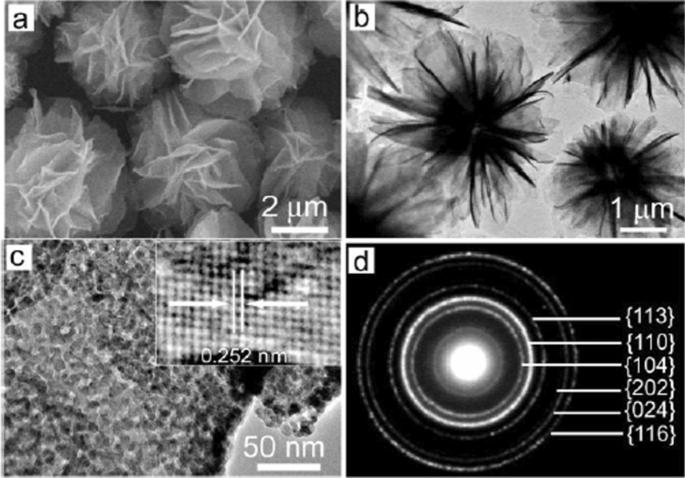
[65]の許可を得て転載。 Copyright、Wiley-VCH
a SEMおよび b 得られたままのα-Fe 2 のTEM画像 O 3 。 c 得られたままのα-Fe 2 の花のような構造の花びらの高倍率TEM画像 O 3 。 d 得られたα-Fe 2 のSAEDパターン O 3 。
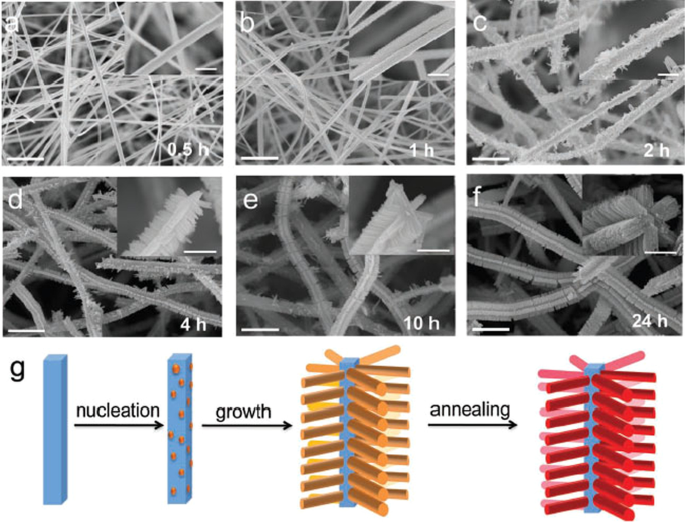
[74]の許可を得て転載。 Copyright、Wiley-VCH
a – f 反応時間を設定することにより、さまざまな反応段階での生成物(アニーリング後)のSEM画像。挿入図は、対応する拡大SEM画像です。図と挿入図のスケールバーは、それぞれ2μmと500nmです。 g 階層的に組み立てられたα-Fe 2 の形成プロセスの概略図 O 3 / SnO 2 ナノコンポジット。
電気化学的方法
電気化学的方法を利用してFe 2 を合成します O 3 ナノ構造、例えば、電気化学的堆積は、Fe 2 の製造に適用されます O 3 ナノ粒子[53]。脱イオン(DI)水とNH 4 を含むエチレングリコール電解質溶液中での鉄箔の陽極酸化による 30〜60 Vの電圧でのF、α-Fe 2 O 3 ナノチューブアレイが得られた[75]。さらに、電気化学的陽極酸化を使用してFe 2 を合成します。 O 3 ナノチューブアレイ[76]。真央他[77]はFe 2 の合成を報告しました O 3 電気化学的堆積を使用したアレイ。彼らの研究では、電気化学的堆積によって鉄がAAOテンプレートチャネルに堆積され、次にAAOテンプレートがNaOH溶液によって除去され、最後に鉄ナノロッドアレイがFe 2 に変換されました。 O 3 配列。この研究の特徴は、沈着の期間を変えることにより、Fe 2 の長さを変えることです。 O 3 ナノロッドは細かく制御できます。
熱処理
Fe 2 を合成するための熱処理 O 3 熱酸化と熱熱分解という2つの重要なアプローチが含まれます。たとえば、Zhang etal。 [54]準備されたFe 2 O 3 350〜650°Cでのプルシアンブルー(PB)マイクロキューブの熱誘導酸化分解によるマイクロボックス(図6)。固体アプローチは、広く使用されている溶液ベースの方法と比較して、均一な異方性中空構造の大規模合成のためのより簡単な方法を提供します。 Fe 2 O 3 さまざまな形態の熱酸化パラメータを使用して準備しました。 α-Fe 2 O 3 鉄ベースの前駆体の容易な熱処理によるナノ構造が提案されている。たとえば、RaoとZheng [71]は、熱処理を利用して、密に整列したα-Fe 2 を作成しました。 O 3 ナノフレークアレイ。
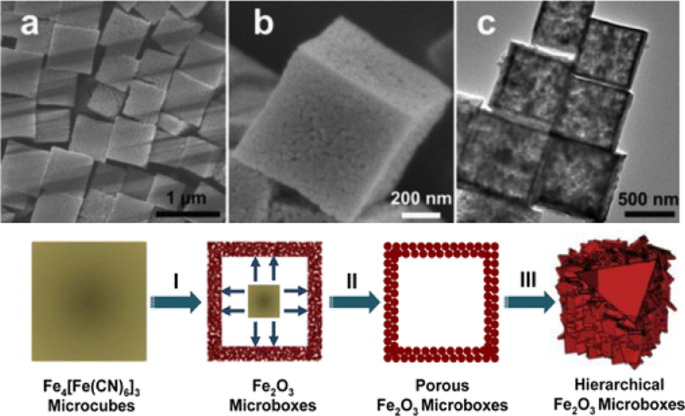
[54]の許可を得て転載。 Copyright、American Chemical Society
a 、 b FESEMと c 中空Fe 2 のTEM画像 O 3 350°Cで得られたマイクロボックス。 d 中空Fe 2 の形成の概略図 O 3 マイクロボックスと、煆焼温度の上昇に伴うシェル構造の進化。
熱分解は、Fe 2 を堆積させるもう1つの一般的な方法です。 O 3 薄膜。 Duret etal。 [78]は、この方法を適用してメゾスコピックα-Fe 2 を取得しました。 O 3 超音波スプレー熱分解によるリーフレットフィルムであり、製造されたフィルムは、従来のスプレー熱分解技術によって製造されたものよりも高い光活性を有する。また、α-Fe 2 の合成 O 3 気相堆積、液相堆積、および熱処理によるナノフレーク、ナノフラワー、ナノワイヤー、およびナノロッドの配列が報告されています[63、71、72、79]。
その他のメソッド
2016年、Guivar etal。 [55]複合空孔秩序マグヘマイト(γ-Fe 2 O 3 )典型的な共沈化学経路を使用して、ナノヒドロキシアパタイト(nanoHAp)で機能化されたナノ粒子。驚くべきことに、γ-Fe 2 O 3 γ-Fe 2 とラベル付けされたnanoHApで機能化 O 3 @HApは、煆焼としての熱処理なしで形成されます。
Fe 2 を合成する方法はたくさんあります O 3 、しかしそれらのほとんどは環境に優しいものではありません。 2019年、Bashir etal。 [56]はα-Fe 2 を得るための環境に優しい方法を開発しました O 3 ナノ粒子、PerseaAmericanaシード抽出物を使用。彼らは2つの異なる前駆体を使用してα-Fe 2 の2つのサンプルを準備しました O 3 、Fe(NO 3 から調製された1つのサンプル(A) ) 3 ・9H 2 O、および別のサンプル(B)はFeCl 3 を準備しました ・9H 2 O。
57 300 K(室温(RT))で記録されたサンプルAおよびBのFeメスバウアースペクトルを図7に示します。 57 Fe Mössbauer spectroscopy is a very valuable technique for exploring the local magnetic behavior and oxidation state of iron atoms in a particular matrix [80]. Both samples revealed magnetic ordering, and displayed only single sextet indicating magnetically ordered state. Table 2 shows 57 Fe extracted Mössbauer parameters at RT, which lists IS, ɛ Q and B hf 。 Both samples’ B hf above 51 T are related to α-Fe2 O 3 [81]. Furthermore, the values of ɛ Q is also consistent with α-Fe2 O 3 。 Both quadrupole interactions indicate Fe as Fe 3+ since the observed IS of 0.3653 mm/s and 0.3754 mm/s for the samples A and B, respectively, are typical for Fe 3+ [82]. Therefore, the negative values of quadrupole splitting indicate the weak ferromagnetic property of the samples A and B, the characteristic of pure α-Fe2 O 3 phase.
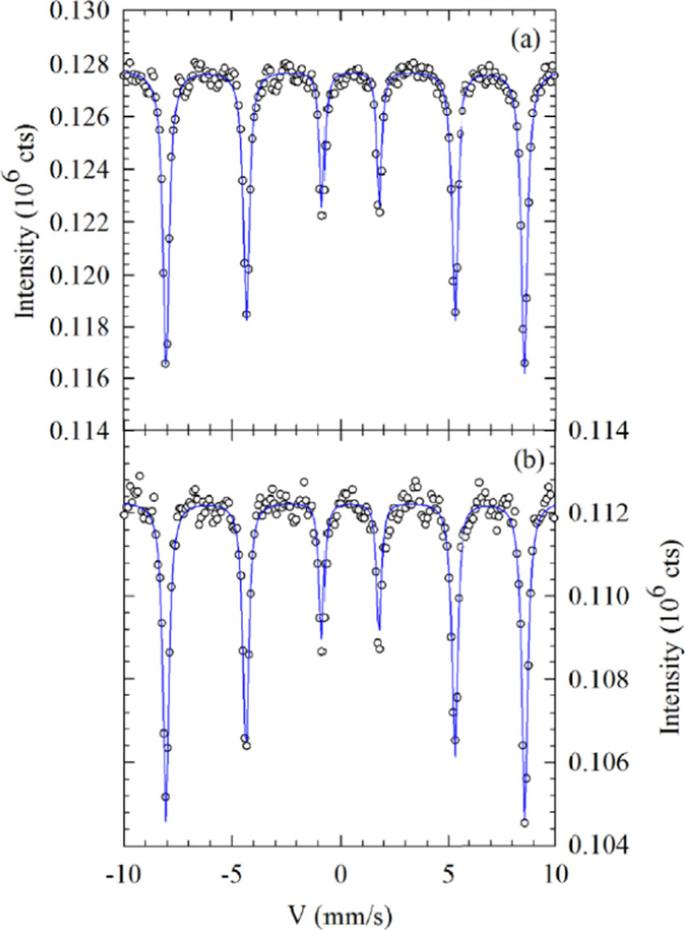
Reprinted with Permission from [56]. Copyright, American Chemical Society
57 Fe Mössbauer spectra recorded at room temperature for α-Fe2 O 3 nanoparticles. a sample A (ferric nitrate as a precursor) and b sample B (ferric chloride as a precursor).
Electrochemical Performance
The charge/discharge cycling at the voltage window of 0.005–3.0 V (vs. Li + ) under a current density of 200 mA g −1 at RT is shown in Fig. 8a. During the initial discharge process, there is an obvious voltage platform of ~ 0.75 V, and it gradually moved to a voltage plateau of ~ 1.0 V, and remain stable in the second and fifth cycles. Meanwhile, an ambiguous plateau was observed at ~ 1.8 V in the charge process. The first discharge profile qualitatively resembles the results by Larcher et al. [83] and Morales et al. [84] on nanoparticle Fe2 O 3 , and Wang et al. [14] on Fe2 O 3 nanotubes. The cycling performance of three samples (hierarchical Fe2 O 3 microboxes, Fe2 O 3 microboxes and porous Fe2 O 3 microboxes) is discribed in Fig. 8b. After 30 cycles, hierarchical Fe2 O 3 microboxes exhibit the highest reversible capacity of 945 mA h g −1 , follow by 872 mA h g −1 for porous Fe2 O 3 microboxes, and finally 802 mA h g −1 for Fe2 O 3 microboxes. The results demonstrated that three samples display excellent cycling stability, and the morphology of nanostructured Fe2 O 3 plays a significant role in determining the discharge characteristics.
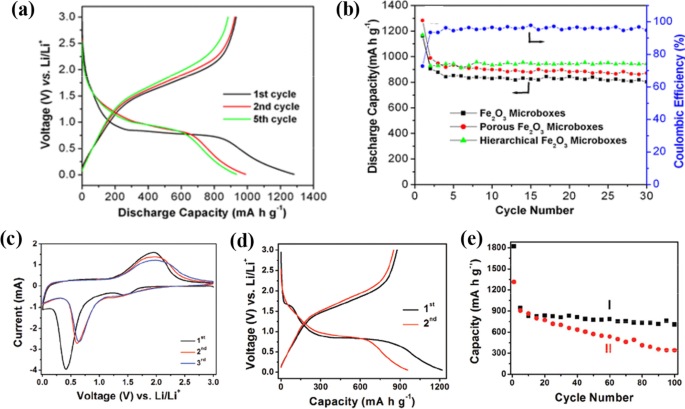
c –e Reprinted with Permission from [85]. Copyright, American Chemical Society
a Discharge − charge voltage profiles of porous Fe2 O 3 microboxes obtained at 550 °C. b Cycling performance of Fe2 O 3 microboxes (350 °C), porous Fe2 O 3 microboxes (550 °C), and hierarchical Fe2 O 3 microboxes (650 °C) and Coulombic efficiency of porous Fe2 O 3 microboxes (550 °C) over the voltage range 0.01 − 3.0 V vs. Li/Li + at the same current density of 200 mA g -1 。 (a , b Reprinted with Permission from [54]. Copyright, American Chemical Society). Electrochemical measurements of the sample. c CVs between 5 mV and 3 V at a scan rate of 0.5 mV s −1 。 d Charge–discharge voltage profiles. e Comparative cycling performance of (I) the as-prepared α-Fe2 O 3 hollow spheres and (II) α-Fe2 O 3 microparticles. All the galvanostatic tests are performed at a constant current rate of 200 mA g −1 between 0.05 and 3 V.
Cyclic voltammogram (CV) is used to characterize the cells with α-Fe2 O 3 nanoflakes anode in the 0.005–3.0 V under a slow scan rate (at RT). Li metal is used as the counter and reference electrodes [20], consistent with previously reported results [85]. CV curves of α-Fe2 O 3 hollow spheres between 5 mV and 3 V at a scan rate of 5 mV s −1 are presented in Fig. 8c. There are apparent redox current peaks, and demonstrate good reversibility of electrochemical reaction. As shown in Fig. 8d, a distinct voltage plateau can be discovered at ~ 0.75 V, consistent with CV curves. The charge–discharge voltage profiles reflect the lithium storage capacity of α-Fe2 O 3 。 The first cyclic discharge capacity and the charge capacity is 1219 mA h g −1 and 877 mA h g −1 respectively, which lead to a relatively low irreversible capacity loss of 28%. In the second cycle, the Coulombic efficiency increased quickly to 89%. Cycling performance of two samples are demonstrated in Fig. 8e. The sample (I) exhibits excellent cyclic capacity retention from the second cycle onward. After 100 cycles of charge/discharge, the reversible capacity is still as high as 710 mA h g −1 。 Compared with α-Fe2 O 3 microparticles, the unique hierarchical α-Fe2 O 3 hollow spheres apparently have enhanced Li storage performance, and a more stable cycling capacity retention and a higher reversible capacity are realized. This superior performance can be attributed to the thin nanosheet subunits that provide rapid and efficient transport of Li + , as well as the unique hollow interior that allows the material to effectively buffer the stress generated during charge/discharge process.
Iron oxides are cheap, abundant and environmentally compatible, and Fe2 O 3 has excellent electrochemical performance. Some of the above studies have shown that Fe2 O 3 based nanostructures can be an alternative anode to replace the presently used graphite in LIBs. The nanostructured Fe2 O 3 has great potential in LIBs anode [86,87,88,89,90,91,92,93,94,95]. Recently, several studies about Fe2 O 3 anode in asymmetric supercapacitors are reported [96,97,98,99,100]. However, low surface area and poor electrical conductivity are still two critical issues limiting the specific capacitance and power density of Fe2 O 3 。 For solutions of these problems, CNTs and CNFs are regarded as conductive matrices to load Fe2 O 3 nanoparticles for realizing improved performance [101]. Table 3 summarizes some typical Fe2 O 3 based nanostructures with their synthesis and electrochemical performance.
<図>Fe3 O4 Based Nanostructures
Magnetite (Fe3 O4 ) and Fe3 O4 based nanostructure composites with pseudocapacitance, high theoretical capacity, environmental friendliness and low cost, are extensively applied to electromagnetic wave absorption [106], LIBs [3, 12, 15], biotechnological devices [107, 108], and supercapacitor [4, 109]. Fe3 O4 nanoparticles is one of the high-performance anodes in electrochemical devices. Unfortunately, Fe3 O4 nanostructures still face some problems, such as a severe volume variation (~ 200%) during the insertion and extraction of Li + and relatively low electrical conductivity, posing negative influence on the cycling stability [19, 110, 111]. From research results, we found that the structure and morphology of Fe3 O4 have a high influence on the electrochemical performance of Fe3 O4 and Fe3 O4 based composites.
Synthesis and Characterization
Recently, nanostructure engineering is demonstrated as a highly-effective approach to obtain improved electrochemical performance of Fe3 O4 and Fe3 O4 based composites. Therefore, various nanostructures including 0D nanoparticles [112], 1D nanorods/wires [113, 114], 2D nanoflakes/sheets [115, 116], 3D hierarchical/porous architectures [117, 118], and hybrid nanostructures of iron oxides [16] are proposed. The electrochemical performance of Fe3 O4 nanostructures can be optimized by rational design of their morphology, composition, porosity and surface characteristics.
Solution phase synthetic method is a facile and rapid way to obtain Fe3 O4 based nanostructures, because of the associative advantages, such as low synthesis temperature (always below 250 °C), easy control of morphology via adjusting hydrothermal conditions (e.g., PH, density of reactant and dosage of active agent, etc.). Solution phase synthetic method includes solvothermal synthesis [119], thermolysis [120], co-precipitation [121], sol–gel process [122, 123], micro-emulsion [124], etc. Simultaneously we compare the pros and cons of these methods.
Solvothermal Synthesis
Solvothermal synthesis, which reacts in a special closed reaction vessel, is one commonly used methods for synthesizing Fe3 O4 。 In a hermetic environment, it is a facile method using aqueous solution as reaction medium at high temperature and high-pressure hermetic environment. Fe3 O4 nanostructures with various morphologies (0D, 1D, 2D and 3D) were synthesized applying this approach.
An et al. [119] obtained the Fe3 O4 /graphene nanowires by solvothermal synthesis and calcination with FeCl3 , NH4 VO3 and graphene as precursors. Phase transition of Fe3 O4 /VOx (FVO) after annealing was confirmed by XRD. For the XRD pattern of sample without annealing, all diffraction peaks of FVO and graphene decorated FVO correspond to FeVO4 ·1.1H2 O. For the XRD pattern of sample after annealing, there are no peaks of any vanadium oxides. And the inductive coupled high frequency plasma (ICP) result indicated that the molarity ratio of Fe and V is ~ 0.94:1, confirming the existence of amorphous vanadium oxide.
Mu et al. [125] reported dispersed Fe3 O4 nanosheets on carbon nanofiber by combing the electrospinning and solvothermal process. In this work, Fe3 O4 nanosheets are uniformly attached on the surface of carbon nanofiber with the diameter of about 500 nm.
Fe3 O4 nanoparticle with high specific surface area via FeCl3 and organic solvent ethanolamine (ETA) as precursors is reported by Wang et al. [126]. In this preparation, ETA is critical factor for compounding Fe3 O4 nanoparticles with high specific surface area, and Fe 3+ is gradually reduced to Fe 2+ by ETA during dissolution process, demonstrating that Fe 2+ increased as the increase of ultrasonication time. The ratio of ETA and FeCl3 has a large impact on the nanoscale grain size and specific surface area of Fe3 O4 。 And the results showed that the grain size of 20–40 nm is achieved with 60 mL ETA and 6 mmol FeCl3 。 When the amount of ETA is 80 mL, smaller nanoparticles (5–10 nm) are obtained.
Another representative work is reported by Chen et al. [127], in which graphene nanosheets decorated with Fe3 O4 nanoparticles (USIO/G) were synthesized using a facile solvothermal process. For the synthesis of USIO composite decorated with reduced graphene oxide (RGO), is used FeCl3 ·H2 O as precursor, then NaHCO3 and L-ascorbic acid were added to form USIO/G. In this process, L-ascorbic acid was oxidized to dehydroascorbic acid (DHAA) by some of Fe 3+ , which were reduced to Fe 2+ 。 Formation process of USIO/G is schematically shown in Fig. 9. The Fe3 O4 nanoparticles with uniform distribution, which are beneficial for electrical conductivity of graphene, mitigation of volume expansion of Fe3 O4 , and facilitating Fe3 O4 particles into the electrolyte.
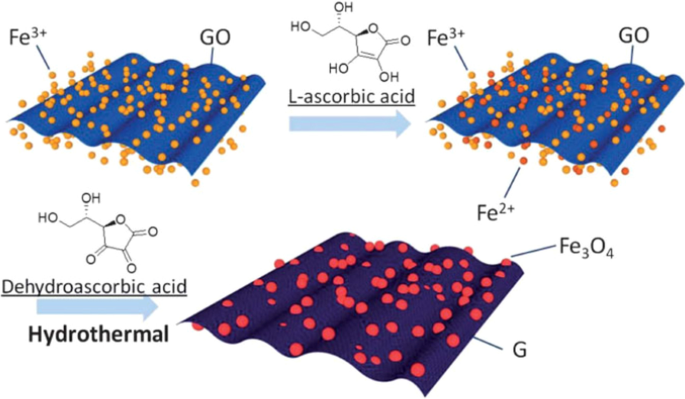
Reprinted with Permission from [127]. Copyright, Royal Society of Chemistry
Schematic illustration of the formation process of USIO/G.
Xiong et al. [128] a kind of hierarchical hollow Fe3 O4 (H-Fe3 O4 ) microspheres prepared by controlled thermal decomposition of iron alkoxide precursor. In a classical reaction, ethylene glycol (EG) serves as reduction reagent that partly reduces Fe 3+ to Fe 2+ with sodium acetate (NaAc), and polyvinylpyrrolidone (PVP) [128]. For this synthesis, PVP served as a surface stabilizer, which has important role in the formation and transformation of hollow interiors.
With the development of solvothermal synthesis, it emerging as an efficient method with the advantages of low energy consumption, little reunion and easy to control shape, etc. Chen et al. [129] synthesized poly (acrylic acid) (PAA)-entangled Fe3 O4 nanospheres by a facile solvothermal method. In their synthesis, the ethylenediamine is crucial to the controlling of the uniformity of nanospheres, and the PAA molecules served as carbon source that transforms into the carbon matrix by heating treatment in inert atmosphere. As shown in SEM image of the prepared C-Fe3 O4 nanospheres, very uniform spherical particles with a diameter of 150–200 nm are synthesized. Observed from SEM images in Fig. 10a, the nanospheres contain small irregular particles, and have a relatively rough surface. In the control experiment without ethylenediamine (EDA), the synthesized particles are much less uniform with a wider size distribution of 100–500 nm, allowing the formation of nanospheres with smaller size.
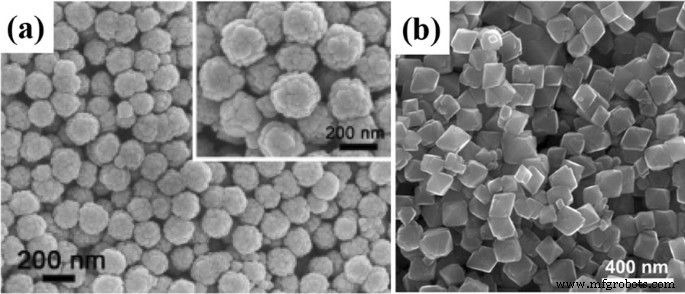
Reprinted with Permission from [130]. Copyright, Wiley–VCH
a SEM images of the Fe3 O4 nanospheres synthesized with ethylenediamine (EDA). The inset of (a ) shows a SEM image with higher magnification. (Reprinted with Permission from [129]. Copyright, American Chemical Society.). Physicochemical characterization of the octahedral Fe3 O4 nanoparticles. b SEM image showing the octahedral geometry of the iron oxide nanoparticles.
Co-precipitation
Due to its high cost-effectiveness, environmental friendliness, and facile synthesizing protocol, co-precipitation is a general approach for Fe3 O4 nanoparticles. Thus, in iron based rechargeable battery systems, Fe3 O4 nanomaterials are especially suitable for large-scale electrochemical applications to solve the energy requirement of the modern society.
Li et al. [121] proposed Fe3 O4 polyhedron as LIBs anode for alkaline secondary batteries by a co-precipitation. Annealing temperature makes a high effect on the physical and electrochemical performance of Fe3 O4 nanomaterials. The 700 °C-annealed Fe3 O4 exhibited a higher electrochemical performance, such as a higher specific discharge capacity of 604.2 mA h g −1 with a charging efficiency of 83.9% at 120 mA g −1 。 Ooi et al. [130] demonstrated octahedral Fe3 O4 nanoparticles using a facile solvothermal route. Scanning electron microscope (SEM) image of Fe3 O4 nanoparticles is shown in Fig. 10b, which depicts that octahedral Fe3 O4 nanoparticles with an average length of 93 ± 18 nm were prepared by the hydrothermal method, showing a roughly Gaussian size distribution. Then, the crystal structure of octahedral nanoparticles can be further evaluated by HRTEM, and the composition of the bulk sample was further characterized by XRD and X-ray photo electron spectroscopy (XPS).
Thermolysis
The thermolysis is small monodisperse magnetic nanocrystals synthesized by organic metal compounds in high boiling point solvents containing stabilizing agent. Previous Organic metal bodies include metal acetylacetone compounds, metal cupferron, or metal Carbonyl compounds, and usually choose fatty acids, oleic acid, or hexadecyl amine as a surfactant. Zhang et al. [120] reported ultrafine Fe3 O4 nanocrystals uniformly encapsulated in two-dimensional (2D) carbon nanonetworks through thermolysis of Fe(C5 H7 O2 )3 precursor at 350 °C under vacuum, which named as 2D Fe3 O4 /C nanonetworks. This facile process using low-cost precursor proposed a green approach for preparing Fe3 O4 /carbon composite. Additionally, compared with the reported Fe3 O4 /carbon composites, the particle size of Fe3 O4 is controllable and a size of ∼ 3 nm can be obtained.
Benefitting from synergistic effects of carbon nanonetworks with excellent electrical conductivity and ultrafine Fe3 O4 particles with uniform distribution, high reversible capacity, excellent rate capability and superior cyclability at the voltage of 0.01–3.0 V (vs. Li/Li + ) are obtained. Nanoparticles with unique iron oxide (Fe3 O4 ) cores and zinc oxide (ZnO) shells were prepared by Jaramillo et al. [131]. Fe3 O4 nanoparticle synthesized through a thermolysis method using Fe(C5 H7 O2 )3 as organic metal body presoma, triethylene glycol as surface active agent, and core–shell Fe3 O4 @ZnO nanoparticles were successfully synthesized using straightforward methodologies. The structural and optical properties of the materials were characterized using a combination of X-ray diffraction, electron microscopy, and light spectroscopy. Importantly, the purity of the core and shell phases in the Fe3 O4 @ZnO nanoparticles was confirmed by both XRD and TEM, and the ZnO shell was shown to increase the transparency of the core–shell nanoparticles relative to the single-component Fe3 O4 nanoparticles. Zhang et al. [132] demonstrated a high crystalline Fe3 O4 -graphene composite by one-step reaction of thermolysis. And they demonstrated that the attachment of iron-organic complex with graphene oxide (GO) sheets can facilely result in magnetic graphene composites via a time-dependent calcination process.
Sol–Gel Process
The specific method is using the metal alkoxide, metal mineral compound or a mixture of the above two substances to hydrolysis and polymerization, uniform gel gradually, then condense into a transparent gel, however, after drying and heating, finally the oxide ultrafine powders was received. Tang et al. [122] prepared nanostructured magnetite thin film by sol–gel method using inexpensive iron (II) chloride precursor. Fe3 O4 nanoparticles were prepared at 300 °C, however, α-Fe2 O 3 is generated when temperature increased to 350 °C, and this result restricts its applications. Xu et al. [123] proposed magnetite nanoparticles by virtue of sol–gel process combined with annealing in vacuum at 200–400 °C using nontoxic and low-cost ferric nitrate. In their study, Fe3 O4 nanoparticles with various sizes can be synthesized facilely through varying the annealing temperature.
Micro-emulsion Method
Micro-emulsion is composed of two mutual miscibility of liquid mixture of thermodynamic stability and isotropy dispersion, one of these or two kinds of liquid called micro area, and fixed by interface layer of the surfactant molecules. The key factors controlling the reaction solution contain concentration, pH value, reaction time and temperature. Micro-emulsion as a rapid expansion of new technology possesses many advantages. For example, high purity and uniform particle size distribution molecular dopant was synthesized at low temperature and simple reaction process. But there are also some shortcomings, for instance, the reaction system mostly contains organic solvents, which leads to high cost, pollution of environmental health and long reaction time. The prepared Fe3 O4 nanoparticles have excellent catalytic performance for the synthesis of quinoxaline in different solvents. Novel core–shell magnetic Fe3 O4 /silica nanocomposites with triblock-copolymer grafted on their surface (Fe3 O4 @SiO2 @MDN) were successfully synthesized by combining sol–gel process with seeded aqueous-phase radical copolymerization approach [133]. The Fe3 O4 @SiO2 @MDN microspheres were synthesized in following three steps. Firstly, the initial magnetic Fe3 O4 microspheres were synthesized by a solvothermal reaction. Then a sol–gel process was utilized to prepare silica coated Fe3 O4 microspheres (Fe3 O4 @SiO2 ), and a thin amorphous silica layer was formed on Fe3 O4 microspheres. Afterward, the Fe3 O4 @SiO2 microspheres were modified by 3-(methacryloxypropyl) trimethoxysilane (MPS). Finally, the triblock copolymer was fabricated by aqueous phase radical copolymerization reaction among MPS, divinylbenzene (DVB) and N-Vinyl-2-pyrrolidone (NVP) on the surface of Fe3 O4 @SiO2 。 The magnetic Fe3 O4 particles with narrow size distribution have nearly spherical shape and smooth surface. Li et al. [124] reported hexagonal and triangular monodisperse Fe3 O4 nanosheets by a two-step microemulsion solvothermal approach, in which the uniform Fe3 O4 nanoparticles are prepared and then these hydrophobic nanocrystals are dispersed in a uniform microemulsion environment as “seeds” for further re-growth through a secondary solvothermal process. In the first step, near-spherical monodisperse 7–8 nm Fe3 O4 nanoparticles were formed through a kinetically controlled process. In the second step, the formation of anisotropic Fe3 O4 nanosheets is a thermodynamically controlled process and all the exposed surfaces of the triangular and hexagonal nanosheets are (111) crystal planes, which have the lowest surface energy for FCC Fe3 O4 。
Other Methods
Physical methods are also significant ways to prepared Fe3 O4 nanostructure for anode of LIBs. Several advantages, such as good crystallization, fine-tuned particle size, and high purity of products are highlighted in recent literatures. But these methods usually demand advanced and expensive equipment, result in a higher cost, poor dispensability of particles dispersion, and agglomeration of nanostructures. For instance, Du et al. [109] fabricated activated carbon (AC)-Fe3 O4 nanoparticles asymmetric supercapacitor, and Fe3 O4 nanostructure was prepared by microwave method. The precursor, FeSO4 ·7H2 O and NH3 ·H2 O mixed solution, was heated in microwave oven. The black precipitate was separated by magnet and washed repeatedly with DI water. The resulted microstructural properties of prepared nanoparticle were characterized by nitrogen adsorption (Quantachrome NOVA 2000), XRD and SEM [109]. Chen et al. [127] synthesized graphene nanosheets decorated with ultra-small Fe3 O4 nanoparticles (USIO/G). Seo et al. [134] reported an integrated usage of magnetic particles in microalgal downstream processes, specifically microalgal harvesting and lipid extraction through one-step aerosol spray pyrolysis and applied in microalgal harvesting and serial microalgal lipid entrapment. TEM/EDS, XPS, and FT-IR analysis suggested that the cationic and lipophilic functionalities arose from not fully decomposed PVP, due to the short residence time in the reactor. Kang et al. [135] proposed Fe3 O4 nanocrystals confined in mesocellular carbon foam (MSU-F–C) by a “host–guest” approach and applied it as LIBs anode. In this study, a precursor of Fe(NO3 )3 ·9H2 O is impregnated in MSU-F–C having uniform cellular pores with a diamter of ~ 30 nm, followed by heating treatment at 400 °C for 4 h in argon (Ar) atmosphere. Fe3 O4 nanocrystals with size of 13–27 nm were fabricated inside the pores of MSU-F–C. The existance of the carbon most likely allows the reduction of some Fe 3+ to Fe 2+ ions by a carbothermoreduction process. The physical performance and pore structure of MSU-F–C and Fe3 O4 -loaded composites were characterized with nitrogen sorption, and the composites have high capacities of ∼800–1000 mA h g −1 at 0.1 A g −1 (∼0.1 C rate), high rate capability and good cycling performance.
Application
Fe3 O4 possesses lots of unique properties, and is highly promising for applications in LIBs and supercapacitors [136,137,138,139,140,141,142]. Table 4 summarizes some applications.
<図>Li-Ion Batteries
Due to conversion reaction of Fe3 O4 during charge/discharge process and other advantages, the Fe3 O4 is usually studied and applied as LIBs anode [143,144,145,146,147]. For TMOs, they have higher theoretical capacity (~ 500–1000 mA h g −1 ) than conventional graphite (about 372 mA h g −1 )。 Furthermore, Fe3 O4 has superior conductivity compared with other transition metal oxides. Thus, it is well-focused by recent studies. It has been reported that composite electrodes with graphene have high performance due to their large surface area, high electrical conductivity and adaptive or flexible structure for high reliability. Qiu et al. [3] reported a kind of composite anode composed of ultra-dispersed Fe3 O4 nanoparticles (3–8 nm) and RGO sheet. It has excellent cyclic performance (624 mA h g −1 for up to 50 charge/discharge cycles at a current density of 0.1 A g −1 ), and good specific capability (624 and 415 mAh g −1 at 0.1 and 2.4 A g −1 , respectively) for LIBs. The obtained Fe3 O4 /RGO exhibited high and ultrastable Photo-Fenton activity (Fig. 11).
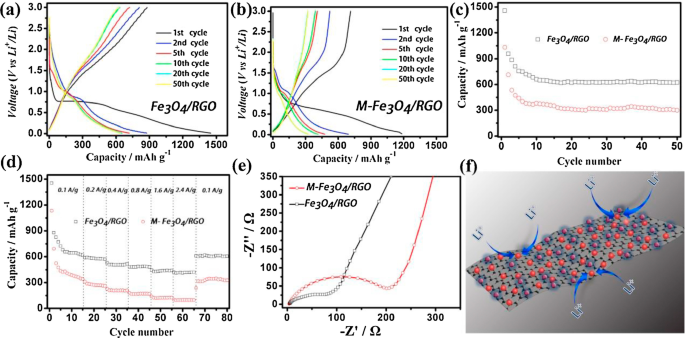
Reprinted with Permission from [3]. Copyright, Elsevier B.V
The charge/discharge curve of Fe3 O4 /RGO composites (a ) and mechanically mixed Fe3 O4 /RGO composites (M-Fe3 O4 /RGO) (b ) electrodes at constant current densities of 0.1 A g −1 。 Cycling performance of Fe3 O4 /RGO composites and M-Fe3 O4 /RGO composites electrode at constant current densities of 0.1 A g −1 (c )。 Rate capability of Fe3 O4/ RGO composites and physically mixed Fe3 O4 /RGO composites at the current densities between 0.1 A g −1 and 2.4 A g −1 (d )。 Nyquist plots of the electrodes of Fe3 O4 /RGO sheet and mechanically mixed Fe3 O4 /RGO composites. All of the measurements were conducted using a voltage window of 0.01–3.0 V (e )。 Schematic representation of the electrochemical reaction path on the Fe3 O4 /RGO composites (f ).
Pyrolyzed carbon is also a good “companion” for Fe3 O4 anodes. Apart from the facile protocol, porous structure formed by pyrolysis always exhibits high specific capacity of Fe3 O4 composite anode. Wang et al. [12] reported hollow N-doped Fe3 O4 /C nanocages with hierarchical porosities by carbonizing polydopamine-coated PB nanocrystals as LIBs anode (Fig. 12). The specific capacity of N-doped Fe3 O4 /C nanocages is ~ 878.7 mA h g −1 after 200 cycles at a current density of 200 mA g −1 , much higher than that of N-doped Fe3 O4 /C derived from pure PB (merely 547 mA h g −1 )。 It is also desirable to design anisotropic structure of Fe3 O4 nanoparticles with carbon coated layer. Zhang et al. [19] reported a kind of carbon-coated Fe3 O4 nanospindles derived from α-Fe2 O 3 nanospindles with length of about 500 nm and an axis ratio of ~ 4. Following by a hydrothermal synthesis method with glucose, the obtained LIBs anode delivered a high reversible capacity of ~ 745 mA h g −1 at C/5 and ~ 600 mA h g −1 at C/2.
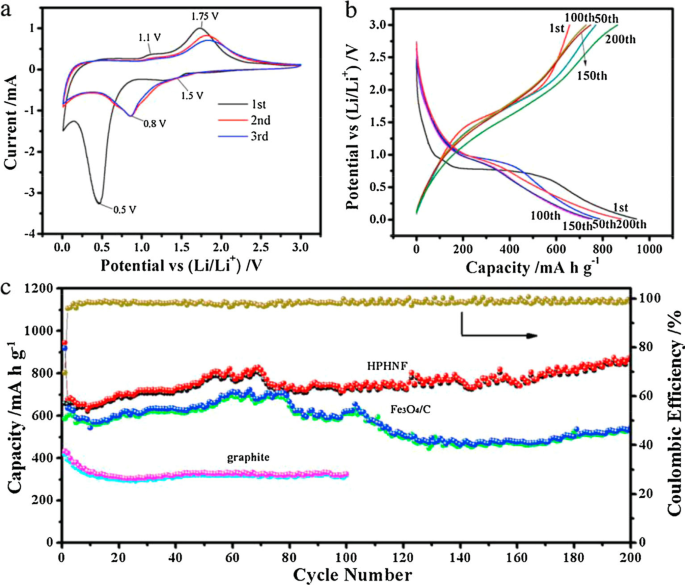
Reprinted with Permission from [12], Copyright, Elsevier Ltd
a CVs of the HPHNF during the first three cycles at 0.2 mV s −1 , b Galvanostatic charge/discharge profiles of the HPHNF electrodes for the 1st, 50th, 100th, 150th and 200th cycle at a specific current of 200 mA g −1 。 c Cycling performance of the HPHNF nanocomposites, N-doped Fe3 O4 /C nanocomposites and graphite at a specific current of 200 mA g −1 。 d Coulombic efficiency of HPHNF.
The most impressive work towards this field is probably the mesoporous iron oxide nanoparticle clusters with carbon coating reported by Lee et al. [148]. After a few cycles, the formation of SEI greatly enhanced the stability of interface between electrode and electrolyte. Electrochemical test exhibited a high specific capacity of 970 mA h g −1 for LIBs.
Supercapacitors
Fe3 O4 is a highly promising candidate for supercapacitor electrode because of its relatively high electrical conductivity, fast reversible redox reaction, low cost and eco-friendly nature [149,150,151,152]. Similar to batteries, high performance supercapacitors also require two factors:large specific surface area and long-term stability. Those two features usually were achieved by building some porous structures and carbon coated layers. Fe3 O4 nanoparticle with a high specific surface area was synthesized by Wang et al. [126] using a bottom up approach. Ferric chloride was firstly sonicated with ethanolamine and then processed through a solvothermal reaction. The obtained active nanomaterials showed a specific surface area of 165.05 m 2 g −1 and a specific capacitance of 207.7 F g −1 at 0.4 A g −1 。
Also, highly dispersed Fe3 O4 nanosheets on 1D CNFs is reported by Mu et al. [125]. The Fe3 O4 /CNFs composites showed a higher specific capacitance than pure Fe3 O4 in 1 M Na2 SO3 。 To further enlarge the specific capacitance and cycle stability, hierarchically porous carbon spheres with Fe3 O4 using as supercapacitors exhibited high capacitivity of 1153 F g −1 at 2 A g −1 and high specific capacitance of 514 F g −1 at 100 A g −1 。 In addition, the assembled asymmetric supercapacitor with double-shelled hollow carbon spheres and Fe3 O4 , has excellent cycling stability (96.7% retention after 8000 cycles) and high energy density (17–45 Wh kg −1 ) at a power density of 400–8000 W kg −1 [4].
Conclusion
Iron oxides (Fe1−x O, Fe2 O 3 , Fe3 O4 ) based nanostructures have much higher specific capacities than those of commercial carbon based anodes. They are considered as highly promising candidates for LIBs anode. However, large irreversible capacity and low cycle stability are two serious problems that obstruct the application of iron oxides based nanostructures. In this review, we summarized the recent progress on novel iron oxides and their composites as LIBs anode and supercapacitor electrode. Several typical synthetic methods of various novel iron oxides based nanostructures are listed. By comparing the electrochemical performance of these various iron oxides based nanostructures, some strategies are expected to solve the problems of iron oxides based nanostructures.
データと資料の可用性
Not applicable.
ナノマテリアル
- Cervoz:産業用アプリケーションに適したフラッシュストレージの選択
- 組み込みアプリケーション向けのAIの最適化
- E-Mobilityアプリケーション用PPA
- エネルギー貯蔵分野に参入する人への3つの大きな質問
- 癌治療のためのナノ粒子:現在の進歩と課題
- 癌用途のための細胞ベースのドラッグデリバリー
- エネルギー貯蔵への応用のための酸化鉄ベースのナノ構造の進歩
- 分数微分方程式に基づくスーパーキャパシタエネルギー貯蔵の推定
- スーパーキャパシター用途の電極としてのグラフェン/ WO3およびグラフェン/ CeOx構造の評価
- 反射防止および超疎水性用途のための金属塩-ポリマーナノコンポジットフィルムの相分離によって形成された表面ナノ構造
- Q&A:エネルギー貯蔵用の石油およびガス井



